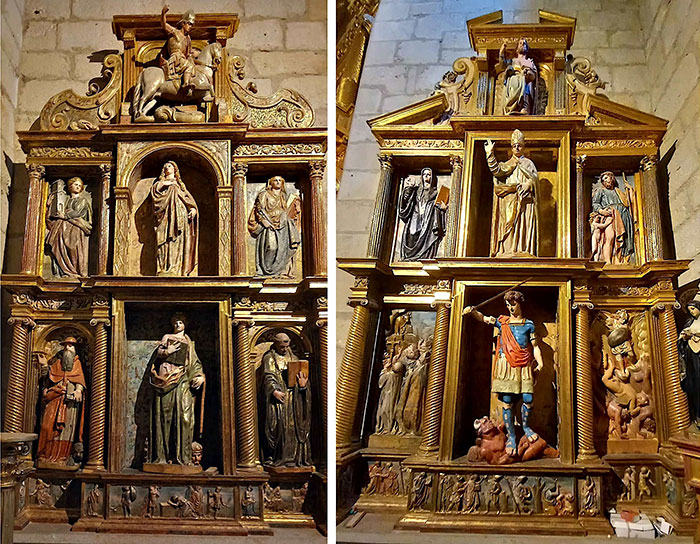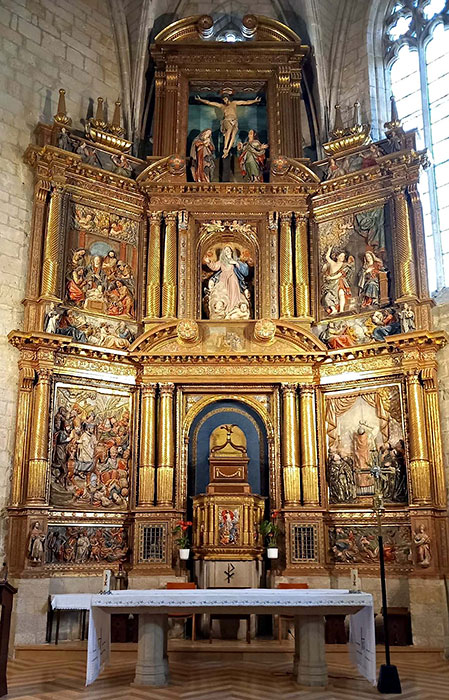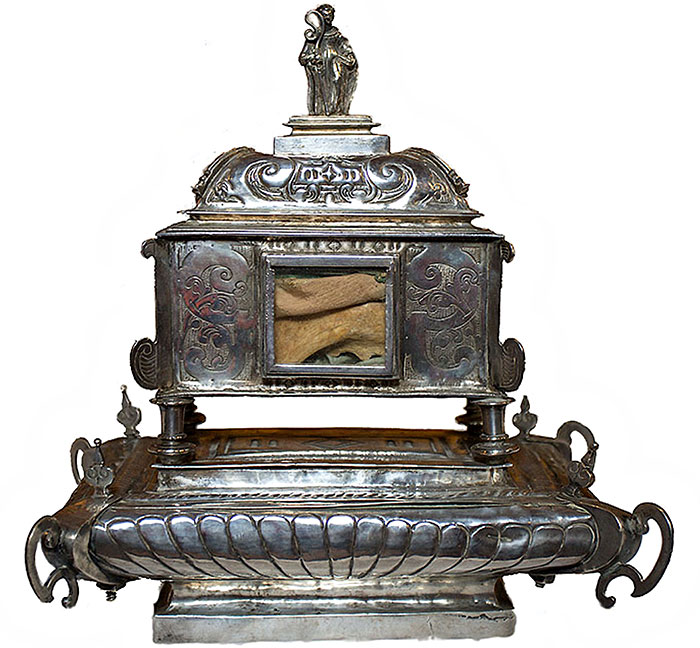August 28
Of battles, miracles and bishops: art and heritage in Villatuerta
José Javier Azanza López
Parish of the Assumption, Villatuerta
The parish of the Assumption of Villatuerta had its origin in a Romanesque building from around 1200, destroyed in the fire of 1378 when the Castilian troops, during the expedition of the prince Juan de Castilla in Navarre that culminated with the siege of Pamplona, razed numerous places, among them Villatuerta. The tower remains from the Romanesque construction, and there is also a Romanesque doorway in the section next to the choir, from the neighboring Shrine of Our Lady of Fair Love de San Román.
Its reconstruction resulted in a late 14th century Gothic church with a single nave of three bays with ribbed vaults and decorated keystones, a pentagonal chancel and a choir loft at the base over a segmental arch, as well as four niche chapels between the buttresses. The sacristy and a portico on the exterior, both from the second half of the 18th century, complete the architectural structure.

Altarpieces of St. Catherine and St. Michael (ca. 1596). Pedro de Troas (sculptor); Miguel de Salazar (polychromator).
Photo: J. J. Azanza.
We focus our interest on this occasion on the parochial trousseau, mainly on its altarpieces. The two collateral ones, Romanesque from the end of the 16th century, are dedicated to St. Catherine and St. Michael respectively, and were executed by the sculptor Pedro de Troas from Estella with polychromy at position by Miguel de Salazar. Worthy of accredited specialization in the altarpiece of Santa Catalina is the carving of its titular, of very slender canon, with the cogwheel and the emperor's head at his feet (he probably also carried a sword that has been lost), to which are added, in the lateral reliefs of the upper body, St. Barbara and St. Apollonia, both with their respective attributes, the tower and the tongs. In the altarpiece of St. Michael, the titular image is flanked by the scenes of the miracle on Mount Gargano and St. Michael defeating the demons.
We must remember that these two altarpieces concealed paintings from the 16th century that have been recovered after the stone was removed in 1986, applying sandblasting and cement mortar. When both altarpieces were removed, these two paintings with paired saints were located: in one of them, St. Catherine and another saint, and in the other, St. Michael and St. Fermin, so that the altarpieces maintain, in their central streets, the headlines of the paintings that were hidden.

Main altarpiece (1643-1645). Pedro Izquierdo (assembler); Juan Imberto III (sculptor); Miguel Ibiricu and Juan Ibáñez (polychromators). Photo: J. J. Azanza.
To the head of the temple is attached the main altarpiece built in the middle of the XVII century to replace a previous one that, a few years before, in 1627, was being repaired because it threatened ruin. In the pastoral visit made in 1640, the bishop Juan Queipo de Llano ordered the construction of the new altarpiece whose execution ran to position of the assembler Pedro Izquierdo and the sculptor Juan Imberto from Estella, while the master painters and gilders from Pamplona Miguel de Ibiricu and Juan Ibáñez were in charge of its polychromy around 1650. According to the contract, it was to take as model the missing altarpiece of the Franciscan convent of Estella.
The altarpiece sample is in the form of a trough, with two bodies of three sections organized by columns of composite capital, topped by an attic with a curved split pediment. In its visual program, the lateral reliefs of the first body stand out for their iconographic singularity. One of them represents a prodigious event of the battle of Las Navas de Tolosa, recorded in De rebus Hispaniae, a work by Archbishop Rodrigo Jiménez de Rada and echoed in later writings, such as Las Navas de Tolosa (1594), a heroic poem by Cristóbal de Mesa. The scene stars three characters on horseback led by Domingo Pascual, canon of the cathedral of Toledo, who carries the triumphal cross and who, according to the story, miraculously crossed the Muslim hosts without suffering any damage. Behind is Archbishop Rodrigo Jiménez de Rada, who with his right hand points to the front, while he turns to speak with King Alfonso VIII, wearing a crown and in an attitude of prayer. We are probably witnessing the end of the conversation between the two, which concludes with the well-known: "Archbishop, I and you die here" from the king to the archbishop, to which the latter replied: "God forbid that you should die here, but today you will defeat our enemies".
For the execution of the relief, Juan Imberto was directly inspired by the etching The Battle of Las Navas de Tolosa, made in Rome in 1589 by the engraver Francisco Villamena (1564-1624) according to a drawing by the Florentine painter Antonio Tempesta (1555-1630) and dedicated to Philip III. This engraving had repercussions in the Spanish art, since it was used by the brothers Jerónimo and Pedro Ruiz de Camargo from Burgos to make in 1594 the mural painting with the battle of Las Navas located in the Monastery of Santa María la Real de las Huelgas (Burgos). Likewise, Las Navas de Tolosa ( 17th century, Museum of Guadalajara), a canvas from the Monastery of San Bartolomé de Lupiana (Guadalajara), from the Madrid school and attributed to Juan de la Corte, follows the same compositional outline . And a third example is found in the Villatuerta altarpiece, which shows that Juan Imberto (from training vallisoletana) knew the Italian print.
The second relief of the main altarpiece depicts the miracle of the dove of Saint Veremundo, abbot of the monastery of Irache in the second half of the 11th century, under the reign of the great protector of the Benedictine monastery, King Sancho el de Peñalén. From the Lectionary of Irache (1547) onwards, the prodigy was widely spread in sermons, liturgical and hagiographic texts of St. Veremundo, such as the General Chronicle of the Order of St. Benedict (1609) by Father Antonio de Yepes and the Life of the Glorious St. Veremundo (1764) by Miguel de Soto. All of them speak of a cruel famine in Navarre that gathered more than three thousand men at the door of the monastery asking for sustenance. Having nothing to feed them, St. Veremundo came to the altar to say mass, at which point a white dove descended from heaven and flew over the heads of those present, who felt satiated as if they had eaten the most succulent delicacies.
The relief, which faithfully follows the textual sources, sample , shows the saint celebrating mass with his back turned, before an altar with a canopy and curtains, at the moment of raising the Sacred Form; several tonsured monks attend the miracle of the dove that appears in the upper right part of the composition among clouds. The beautiful polychromy of the whole is outstanding, especially the lateral bands of the saint's chasuble with delicate bouquets.
Also on this occasion Juan Imberto had graphic sources, as well as textual ones, for the execution of the relief. Specifically, the chest of Saint Veremundo (1584) of the parish of San Emeterio and San Celedonio of Dicastillo, in whose execution Francisco de Iciz, Martín de Morgota and Pedro de Gabiria took part. The reliefs of one of its main fronts are dedicated to the miracle of the dove and the celebration of the mass, scene that sample an evident parallelism with the relief of Villatuerta.

Architrave-reliquary of Saint Veremundo (1640). Agustín de Herrera. Photo: F. Echeverría(De escoplo, pincel y buril, p. 51).
In addition to the cult of Saint Veremundo, the parish of Villatuerta conserves an exceptional piece of gold and silverware, the silver reliquary chest (1640) commissioned to the silversmith Agustín de Herrera. It consists of a rectangular base with ornamentation of gallons and the angles marked by ces and exempt pyramidal finials, on which is mounted the chest itself with cylindrical legs and bulbous cover, topped by the statuette of the saint.
We finish this tour with the accredited specialization to two sculptures of St. Veremundo. One of them is a wood carving that preserves a registration on the base: "E. Lombardi. Ancha nº 3.- Barcelona". The image, currently on a pedestal, was placed in 1872 on the altar of St. Veremundo erected in the presbytery on the Gospel side. The second is the commemorative monument to St. Veremundo (2010), made in the workshops of José Ángel Veremundo San Martín, a sculptor born in Villatuerta. sample the saint in an attitude of blessing, accompanied by his crosier and the abbey mitre at his feet. It replaces a previous one made in stone in 1999 by the sculptor Juan Chivite.
To learn more:
FERNÁNDEZ GRACIA, R., De escoplo, pincel y buril. La imagen de san Veremundo desde Irache, Estella, Ayuntamientos de Arellano, Ayegui, Dicastillo, Estella y Villatuerta, 2020.
GARCÍA GAINZA, M.ª C. (dir.), Catalog Monumental de Navarra. II**. Merindad de Estella, Pamplona, Government of Navarre, 1983.
IBÁÑEZ, E., Esbozo histórico de la Villa y Parroquia de Villatuerta, Villatuerta, Ayuntamiento, 1930.
MAÑERU, L., Villatuerta, nuestro pueblo, Villatuerta, Ayuntamiento, 2012.
